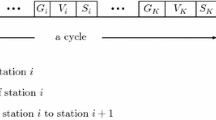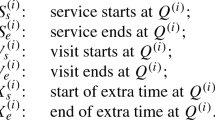Abstract
We consider gated polling systems with two special features: (i) retrials and (ii) glue or reservation periods. When a type-i customer arrives, or retries, during a glue period of the station i, it will be served in the following service period of that station. Customers arriving at station i in any other period join the orbit of that station and will retry after an exponentially distributed time. Such polling systems can be used to study the performance of certain switches in optical communication systems. When the glue periods are exponentially distributed, we obtain equations for the joint generating functions of the number of customers in each station. We also present an algorithm to obtain the moments of the number of customers in each station. When the glue periods are generally distributed, we consider the distribution of the total workload in the system, using it to derive a pseudo-conservation law which in turn is used to obtain accurate approximations of the individual mean waiting times. We also investigate the problem of choosing the lengths of the glue periods, under a constraint on the total glue period per cycle, so as to minimize a weighted sum of the mean waiting times.




Similar content being viewed by others
References
Abidini, M.A., Boxma, O.J., Resing, J.A.C.: Analysis and optimization of vacation and polling models with retrials. Perform. Eval. 98, 52–69 (2016)
Abidini, M.A., Boxma, O.J., Koonen A.M.J., Resing, J.A.C.: Revenue maximization in an optical router node—allocation of service windows. In: International Conference on Optical Network Design and Modelling (ONDM), Cartagena (2016)
Artalejo, J.R., Gómez-Corral, A.: Retrial Queueing Systems: A Computational Approach. Springer, Berlin (2008)
Avrachenkov, K., Morozov, E., Steyaert, B.: Sufficient stability conditions for multi-class constant retrial rate systems. Queueing Syst. 82, 149–171 (2016)
Boon, M.A.A., van der Mei, R.D., Winands, E.M.M.: Applications of polling systems. Surv. Oper. Res. Manag. Sci. 16, 67–82 (2011)
Boxma, O.J.: Workloads and waiting times in single-server systems with multiple customer classes. Queueing Syst. 5, 185–214 (1989)
Boxma, O.J., Kella, O., Kosiński, K.M.: Queue lengths and workloads in polling systems. Oper. Res. Lett. 39, 401–405 (2011)
Boxma, O.J., Resing, J.A.C.: Vacation and polling models with retrials. In: 11th European Workshop on Performance Engineering (EPEW 2014), Florence (2014)
Everitt, D.: Simple approximations for token rings. IEEE Trans. Commun. 34, 719–721 (1986)
Falin, G.I.: On a multiclass batch arrival retrial queue. Adv. Appl. Probab. 20, 483–487 (1988)
Falin, G.I., Templeton, J.G.C.: Retrial Queues. Chapman and Hall, London (1997)
Langaris, C.: A polling model with retrial customers. J. Oper. Res. Soc. Jpn. 40, 489–508 (1997)
Langaris, C.: Gated polling models with customers in orbit. Math. Comput. Model. 30, 171–187 (1999)
Langaris, C.: Markovian polling system with mixed service disciplines and retrial customers. Top 7, 305–322 (1999)
Langaris, C., Dimitriou, I.: A queueing system with \(n\)-phases of service and \((n-1)\)-types of retrial customers. Eur. J. Oper. Res. 205, 638–649 (2010)
Levy, H., Sidi, M.: Polling models: applications, modeling and optimization. IEEE Trans. Commun. 38, 1750–1760 (1990)
Moutzoukis, E., Langaris, C.: Non-preemptive priorities and vacations in a multiclass retrial queueing system. Stoch. Models 12, 455–472 (1996)
Okawachi, Y., Bigelow, M.S., Sharping, J.E., Zhu, Z., Schweinsberg, A., Gauthier, D.J., Boyd, R.W., Gaeta, A.L.: Tunable all-optical delays via Brillouin slow light in an optical fiber. Phys. Rev. Lett. 94, 153902 (2005). (4pages)
Takagi, H.: Application of polling models to computer networks. Comput. Netw. ISDN Syst. 22, 193–211 (1991)
Takagi, H.: Queueing analysis of polling models: progress in 1990–1994. In: Dshalalow, J.H. (ed.) Frontiers in Queueing: Models, Methods and Problems, pp. 119–146. CRC Press, Boca Raton (1997)
Takagi, H.: Analysis and application of polling models. In: Haring, G., Lindemann, C., Reiser, M. (eds.) Performance Evaluation: Origins and Directions. Lecture Notes in Computer Science, vol. 1769, pp. 423–442. Springer, Berlin (2000)
Vishnevskii, V.M., Semenova, O.V.: Mathematical methods to study the polling systems. Autom. Remote Control 67, 173–220 (2006)
Winands, E.M.M.: Branching-type polling systems with large setups. OR Spectr. 33, 77–97 (2011)
Acknowledgements
We are grateful to the reviewer and the associate editor for valuable comments and suggestions, which considerably improved this paper. The research is supported by the IAP program BESTCOM, funded by the Belgian government, and by the Gravity program NETWORKS, funded by the Dutch government. The authors gratefully acknowledge several discussions with Professor Ton Koonen (TU Eindhoven) about optical communications. B. Kim’s research was supported by the National Research Foundation of Korea (NRF) grant funded by the Korea government (MSIP) (NRF-2017R1A2B4012676). J. Kim’s research was supported by Basic Science Research Program through the National Research Foundation of Korea (NRF) funded by the Ministry of Education (2017R1D1A1B03029542).
Author information
Authors and Affiliations
Corresponding author
Appendix: Approximation of the mean waiting times
Appendix: Approximation of the mean waiting times
Below we outline a method to approximate the mean waiting times of all customer types. The arrival of a type-i customer occurs either during a glue period of station i or during any other period. At the start of the service period, the customers which will be served in the current service period are fixed. The mean length of the service period is now the same irrespective of the order in which these customers are served. Without loss of generality, we will assume that the customers who arrive during a glue period of station i are served first and then customers who retry are served.
Let \(\bar{W}_i\) and \(\tilde{W}_i\) denote the waiting times of type-i customers who arrive during a glue period of station i and any other period, respectively. Further, \(G_{i_\mathrm{res}}\) denotes the residual time of a glue period of station i. Finally, \(C_{i_\mathrm{res}}\) denotes the residual time of a non-glue period of station i. A type-i customer arriving during a glue period of station i has to wait for the residual glue period. Further, it has to wait for all the customers who arrived before it during the glue period. Therefore,
A type-i customer arriving during a non-glue period of station i has to wait for the residual non-glue period and the glue period. Then, it either gets in the queue for service or it remains in the orbit. With probability \(\tilde{G}_i (\nu _i)\) it remains in the orbit and has to wait until the next visit to get served, and this repeats. Therefore, on average, it has to wait for \(\tilde{G}_i (\nu _i)/(1-\tilde{G}_i (\nu _i))\) cycles before it gets into the queue for service. When it gets in the queue, it has to wait for all the type-i customers who have arrived during the glue period to be served, and then the customers who arrived before it and who will be served in the current service period (on average this number is approximately equal to the number of customers who arrived during the residual non-glue period before the arrival of the tagged customer). Therefore,
The probability that a type-i customer arrives during a glue period of station i is \(\mathbb {E}[G_i]/\mathbb {E}[C]\), and the probability that it arrives during a non-glue period equals \(1-(\mathbb {E}[G_i]/ \mathbb {E}[C])\). Therefore,
Let \(R_{c_i}\) be the residual cycle time of the system with respect to station i. Then,
We assume that \(\mathbb {E}[R_{c_i}] =\mathbb {E}[R_{c}]\) for all \(i=1,\ldots ,N\). We thus obtain (4.11):
Rights and permissions
About this article
Cite this article
Abidini, M.A., Boxma, O., Kim, B. et al. Performance analysis of polling systems with retrials and glue periods. Queueing Syst 87, 293–324 (2017). https://doi.org/10.1007/s11134-017-9545-y
Received:
Revised:
Published:
Issue Date:
DOI: https://doi.org/10.1007/s11134-017-9545-y




